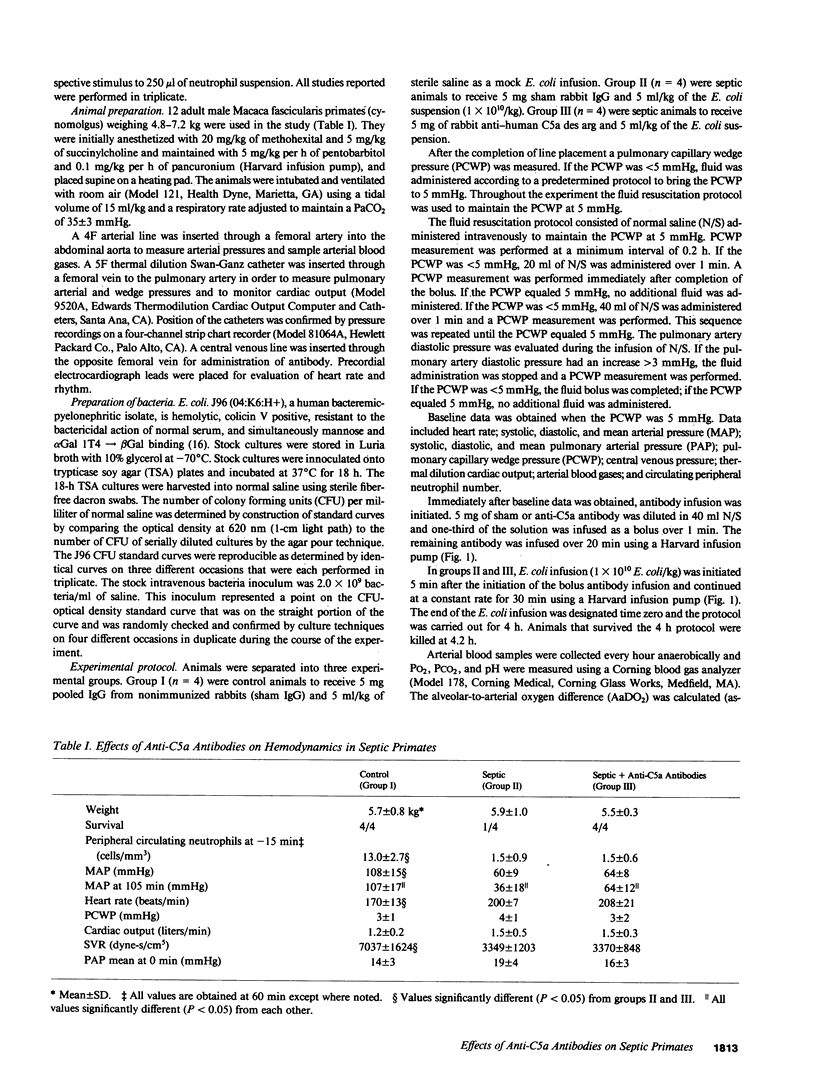Abstract
In vitro and in vivo studies have suggested that human complement component C5a plays a key role in neutrophil injury in the adult respiratory distress syndrome (ARDS). First, using leukocyte aggregometry, we demonstrated that the addition of a recently developed rabbit anti-human polyclonal antibody to C5a des arg to endotoxin-activated plasma prevented leukocyte aggregation in vitro. We then administered the anti-C5a des arg antibody to septic primates (Macaca fascicularis). Three groups of primates, control, septic, and anti-C5a antibody treated septic, were studied (n = 4 in each group). A 30-min infusion of Escherichia coli (1 X 10(10)/kg) resulted in severe sepsis and ARDS. Primates were killed 4 h after completion of the E. coli infusion. Septic animals not treated with anti-C5a antibody had 75% mortality (3/4), decreased oxygenation, severe pulmonary edema, and profound hypotension. Septic primates treated with anti-C5a antibodies did not die and did not develop decreased oxygenation (P less than 0.05) or increased extravascular lung water (P less than 0.05). They also had a marked recovery in their mean arterial blood pressure (P less than 0.05). This study demonstrates that treatment with rabbit anti-human C5a des arg antibodies attenuates ARDS and some of the systemic manifestations of sepsis in nonhuman primates.
Full text
PDF




Selected References
These references are in PubMed. This may not be the complete list of references from this article.
- Craddock P. R., Hammerschmidt D., White J. G., Dalmosso A. P., Jacob H. S. Complement (C5-a)-induced granulocyte aggregation in vitro. A possible mechanism of complement-mediated leukostasis and leukopenia. J Clin Invest. 1977 Jul;60(1):260–264. doi: 10.1172/JCI108763. [DOI] [PMC free article] [PubMed] [Google Scholar]
- Fein A. M., Lippmann M., Holtzman H., Eliraz A., Goldberg S. K. The risk factors, incidence, and prognosis of ARDS following septicemia. Chest. 1983 Jan;83(1):40–42. doi: 10.1378/chest.83.1.40. [DOI] [PubMed] [Google Scholar]
- Fowler A. A., Hamman R. F., Good J. T., Benson K. N., Baird M., Eberle D. J., Petty T. L., Hyers T. M. Adult respiratory distress syndrome: risk with common predispositions. Ann Intern Med. 1983 May;98(5 Pt 1):593–597. doi: 10.7326/0003-4819-98-5-593. [DOI] [PubMed] [Google Scholar]
- Gelfand J. A., Donelan M., Hawiger A., Burke J. F. Alternative complement pathway activation increases mortality in a model of burn injury in mice. J Clin Invest. 1982 Dec;70(6):1170–1176. doi: 10.1172/JCI110715. [DOI] [PMC free article] [PubMed] [Google Scholar]
- Hammerschmidt D. E., Bowers T. K., Lammi-Keefe C. J., Jacob H. S., Craddock P. R. Granulocyte aggregometry: a sensitive technique for the detection of C5a and complement activation. Blood. 1980 Jun;55(6):898–902. [PubMed] [Google Scholar]
- Hammerschmidt D. E., Weaver L. J., Hudson L. D., Craddock P. R., Jacob H. S. Association of complement activation and elevated plasma-C5a with adult respiratory distress syndrome. Pathophysiological relevance and possible prognostic value. Lancet. 1980 May 3;1(8175):947–949. doi: 10.1016/s0140-6736(80)91403-8. [DOI] [PubMed] [Google Scholar]
- Hosea S., Brown E., Hammer C., Frank M. Role of complement activation in a model of adult respiratory distress syndrome. J Clin Invest. 1980 Aug;66(2):375–382. doi: 10.1172/JCI109866. [DOI] [PMC free article] [PubMed] [Google Scholar]
- Hugli T. E., Gerard C., Kawahara M., Scheetz M. E., 2nd, Barton R., Briggs S., Koppel G., Russell S. Isolation of three separate anaphylatoxins from complement-activated human serum. Mol Cell Biochem. 1981 Dec 4;41:59–66. doi: 10.1007/BF00225297. [DOI] [PubMed] [Google Scholar]
- Hull R. A., Gill R. E., Hsu P., Minshew B. H., Falkow S. Construction and expression of recombinant plasmids encoding type 1 or D-mannose-resistant pili from a urinary tract infection Escherichia coli isolate. Infect Immun. 1981 Sep;33(3):933–938. doi: 10.1128/iai.33.3.933-938.1981. [DOI] [PMC free article] [PubMed] [Google Scholar]
- Mihm F. G., Feeley T. W., Rosenthal M. H., Lewis F. Measurement of extravascular lung water in dogs using the thermal-green dye indicator dilution method. Anesthesiology. 1982 Aug;57(2):116–122. doi: 10.1097/00000542-198208000-00009. [DOI] [PubMed] [Google Scholar]
- O'Hanley P., Lark D., Falkow S., Schoolnik G. Molecular basis of Escherichia coli colonization of the upper urinary tract in BALB/c mice. Gal-Gal pili immunization prevents Escherichia coli pyelonephritis in the BALB/c mouse model of human pyelonephritis. J Clin Invest. 1985 Feb;75(2):347–360. doi: 10.1172/JCI111707. [DOI] [PMC free article] [PubMed] [Google Scholar]
- Parrish D. A., Mitchell B. C., Henson P. M., Larsen G. L. Pulmonary response of fifth component of complement-sufficient and -deficient mice to hyperoxia. J Clin Invest. 1984 Sep;74(3):956–965. doi: 10.1172/JCI111515. [DOI] [PMC free article] [PubMed] [Google Scholar]
- Sacks T., Moldow C. F., Craddock P. R., Bowers T. K., Jacob H. S. Oxygen radicals mediate endothelial cell damage by complement-stimulated granulocytes. An in vitro model of immune vascular damage. J Clin Invest. 1978 May;61(5):1161–1167. doi: 10.1172/JCI109031. [DOI] [PMC free article] [PubMed] [Google Scholar]
- Starkebaum G., Jimenez R. A., Arend W. P. Effect of immune complexes on human neutrophil phagocytic function. J Immunol. 1982 Jan;128(1):141–147. [PubMed] [Google Scholar]
- Stevens J. H., Raffin T. A. Adult respiratory distress syndrome--I. Aetiology and mechanisms. Postgrad Med J. 1984 Aug;60(706):505–513. doi: 10.1136/pgmj.60.706.505. [DOI] [PMC free article] [PubMed] [Google Scholar]
- Tonnesen M. G., Smedly L. A., Henson P. M. Neutrophil-endothelial cell interactions. Modulation of neutrophil adhesiveness induced by complement fragments C5a and C5a des arg and formyl-methionyl-leucyl-phenylalanine in vitro. J Clin Invest. 1984 Nov;74(5):1581–1592. doi: 10.1172/JCI111574. [DOI] [PMC free article] [PubMed] [Google Scholar]
- Wechter W. J., Nelson J. W., Perper R. J., Parcells A. J., Riebe K. W., Evans J. S., Satoh P. S., Ko H. Manufacture of antithymocyte globulin (ATGAM) for clinical trials. Transplantation. 1979 Oct;28(4):303–307. doi: 10.1097/00007890-197910000-00007. [DOI] [PubMed] [Google Scholar]


